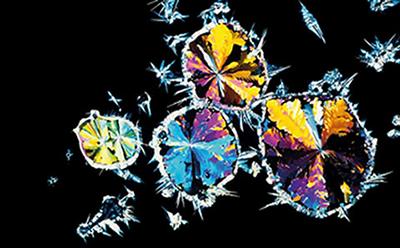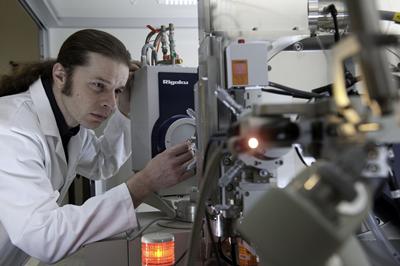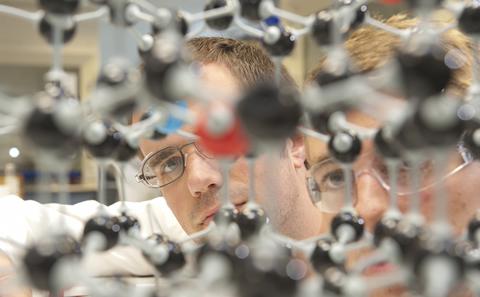Research is clear on the study of crystals

Crystals form the building blocks of much of our world. Studying them closely enables us to understand the structure of biomolecules of things like our bones and muscles - even the chocolate in our advent calendars.
At the University of Southampton, research from the National X-ray Crystallography Service, supported by the Engineering and Physical Sciences Research Council, uses innovative techniques to provide data collection and crystal structure analysis for the UK chemistry community for a wide range of applications.
Southampton’s links with this vital research are reflected on the University’s annual Christmas card with an image of crystals.
X-ray crystallography has developed at a rapid pace in the last 20 years after the technique was first used over 100 years ago when salt was the first crystal structure to be determined using the technique.
In essence, the method involves placing a tiny crystal in the path of an X-ray beam. As the X-ray passes through the crystal, the radiation is diffracted into a pattern by the atoms that make up the molecules in the crystal structure.
The diffraction pattern is like a fingerprint that identifies not only the nature of the atoms and bonds in the molecules, but also their three-dimensional arrangement. It is the only analytical method that can achieve this level of analysis in such a complete and unambiguous fashion.

But how much do we really know about crystallography and the benefits it brings to science and society as a whole?
With help from Dr Simon Coles, Associate Professor and Director of the UK National Crystallography Service, here are five things you may not have known about crystals and crystallography that will put you on the road to becoming something of a seasonal expert on the science.
Five things you might not know about crystallography
1. Last year – 2014 – was the UNESCO Year of Crystallography.
The father and son combination of father William Henry Bragg and son William Lawrence Bragg first revealed the structure of salt and won the Nobel Prize in Physics in 1915 for their services ‘in the analysis of crystal structure by means of X-ray’. To date, the Braggs are the only father and son team to receive a Nobel Prize. In fact, Crystallography is the science or discipline directly attributable to winning the most Nobel Prizes, taking the award 28 times.
2. Around 90 per cent of all drugs are actually crystals.
That’s because it’s much easier to control the solid state of a crystalline structure - even if you’re using a gel, that would involve crystals that are suspended in a gooey substance to aid the delivery of the drug involved. Some drugs that are injected would also be comprised of small crystals as crystalline materials can be arranged in different ways, under different conditions, to create the required effect.
If you take a tablet, it has to dissolve in your gut and get across the gut wall into the bloodstream. How the crystals in the drugs are composed will define how readily they will dissolve in your gut. If you get the wrong form, the drug might go all the way through the body, or dissolve in the wrong place and be useless.
3. Did you know that quite a lot of the human body is made of crystals?
For example, most of the rods and cones in your eye that conduct the light or form an image are made of crystals. Around 65 per cent of the bone mass of an adult is made of hydroxyapatite crystal.
4. Another thing to consider, especially during the seasonal period, is that chocolate is crystalline.
The National X-ray Crystallography Service at Southampton has done a number of experiments on the crystalline structures of chocolate. The cocoa butter added controls the crystallinity and that is important because there are six different crystalline forms of chocolate. Perhaps surprisingly, the one that most chocolate wants to be – the most stable form – is the nasty one with the white coating on the top that nobody likes the taste of, but that’s what chocolate ultimately wants to be.
If you play around with the amount of cocoa butter, that affects the crystalline nature of the chocolate and that’s how you get different forms, tastes and textures and, hopefully, will direct you to the form of chocolate that everybody knows and loves.
5. Many people will be enjoying fireworks over the holiday period, but did you know that explosives are all crystals?
Here in Southampton, we have developed a new class of solid compound that means that you would no longer need to mix powders to create fireworks, much as the Chinese were doing centuries ago. The problem with explosive powders, or other substances like nitro-glycerine, is their volatility. However, if they were to be created in a more stable solid state, they would be safer to transport and easier to control.
One answer we have discovered is to move towards a different kind of high-energy material by growing crystals with firework-type properties in a scaffold or lattice-like structure, which stays stable and features channels and voids where you can put things like different dyes to create different colours. You could even put nitro-glycerine within such a structure and it would stay stable for as long as you like.
The applications for this kind of firework are not just for entertainment or defence. The airbags in our cars are also initiated by energetic materials that are all mini fireworks, so there are many civilian applications for these crystals as well.

Our research
Find out more about our research and how we are changing the world for the better
-standard-medium.jpg_SIA_JPG_fit_to_width_MEDIUM.jpg)
Our latest news
Read more of our latest news articles